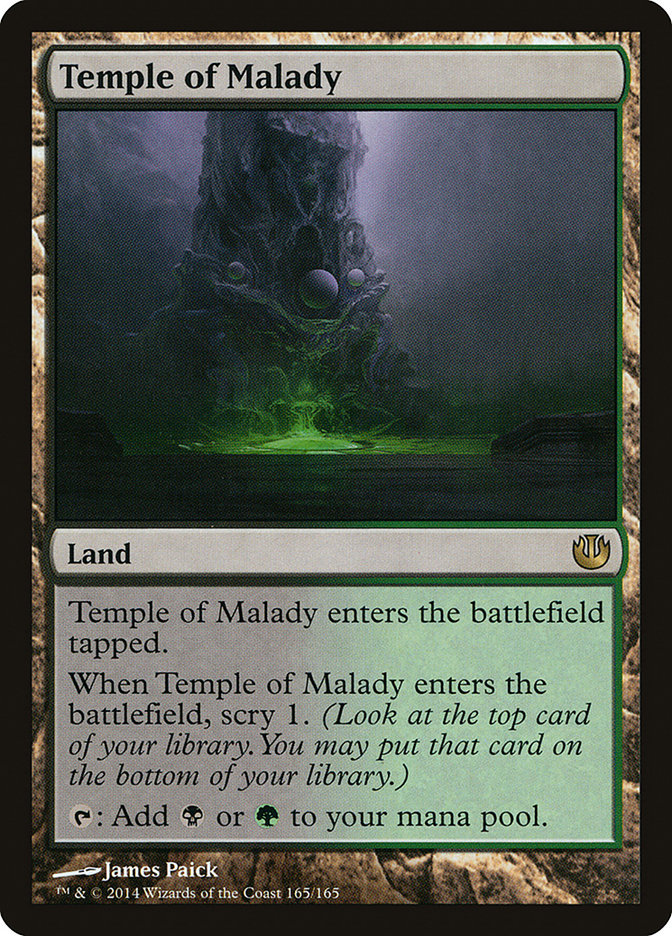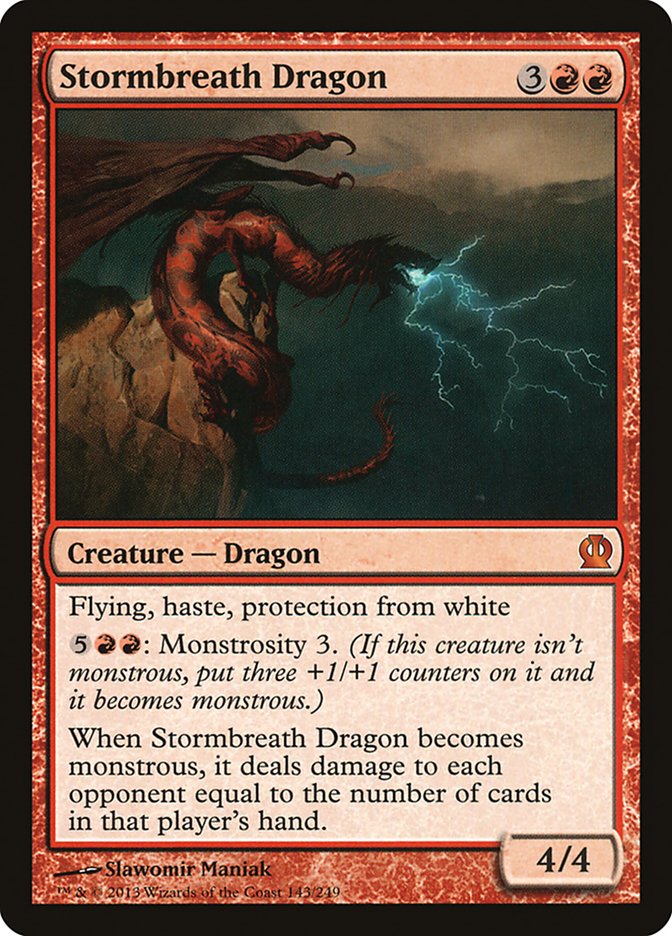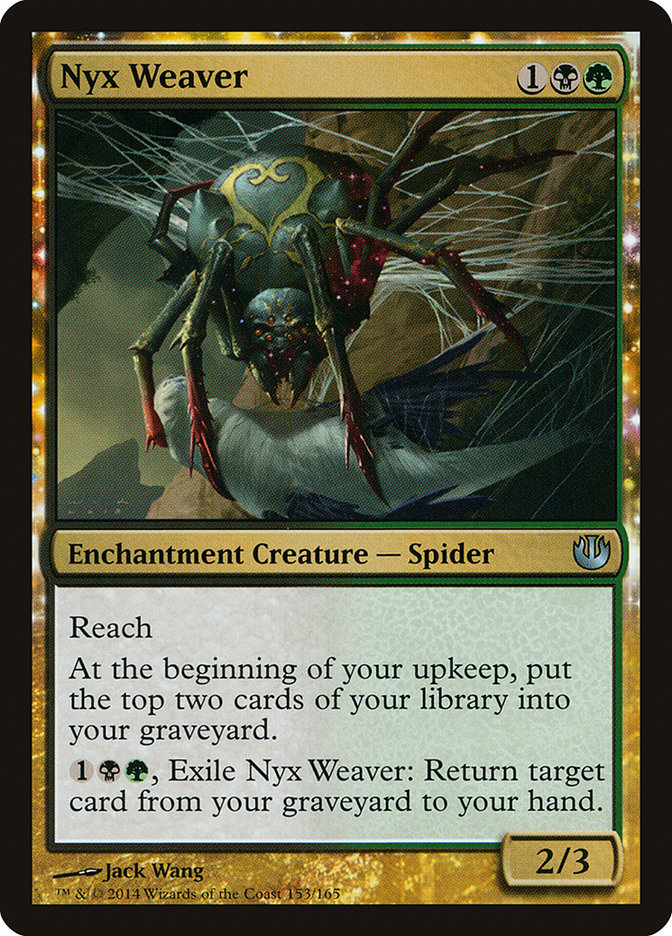The first Standard Open of the format is in the books. As was the case last time, the first Open was won by a deck with no new cards.
Well, not quite:
Therefore, we can assume Temple of Malady is not only the best card in the new set, but also that it is better than the entire set of Born of the Gods.
Just kidding, maybe.
While I was not thrilled with Born of the Gods, I think I may have underrated the good cards. It took a while for some of those cards to infiltrate the
ranks of the format as it was. Kiora and the Temples (good name for a band?) were the early frontrunners for the cards that mattered the most, but then
Pain Seer and Herald of Torment showed up and all of that changed. Of course, as the season wore on Kiora came back and Pain Seer was really just one of
many options in a pretty diverse format that was ever punctuated by not only Pack Rats but also Sphinx’s Revelations.
So, what do we have now?
So far we have a black devotion deck that splashes green and still manages to play two Golgari Guildgates; however, I do think ten sources for four
maindeck cards and two sideboard cards is enough:
Creatures (16)
Planeswalkers (1)
Lands (25)
Spells (18)
Sideboard

Four Pack Rat, zero Bile Blight. Erebos is in the sideboard. It seems like this deck has roughly all the tools it could want and has not really given
anything up. The norm was to eschew Nightveil Specter for Lifebane Zombie anyway, which means splashing doesn’t really hurt. While I’m not alone in this
thought, I am sure this will be one of the first decks I try once I can start playing the deck online. The green splash is natural, and one that we’ve seen
before. It strengthens you against blue control decks by presenting an uncounterable answer to not only Detention Sphere but now also Banishing Light.
Vraska is an equally great addition to the deck, as it gives you a way to gain an advantage or maintain parity against a Planeswalker that’s already been
activated, by not losing a card while killing it (as you might with Hero’s Downfall, for example).
Eric Rill lost in the finals with U/W Control featuring one copy of Banishing Light and two copies of Nyx-Fleece Ram, as well as one Deicide. Six Temples,
three Mutavaults, and the full four Azorius Guildgates allow him to cast his pair of Celestial Flares as well as his maindeck Jace, Memory Adept. I am fond
of the Elixir of Immortality being in his deck, as it basically makes me feel like I cannot lose (your feelings of invincibility may vary!). Had I played
in the event I likely would have played a U/W Control deck, and I’m not sure how well I would have done. The Celestial Flares address a specific concern
I’ve had while playing the deck, which is Stormbreath Dragon.
This is not a new card, but it is as potent as ever. As a control player, it punishes you for casting spells on your own turn, as you cannot remove it with
any of your normal removal spells save Supreme Verdict, and it will often kill the Planeswalker you spent the turn casting, or continue to pressure you
after you cleared the board with your first Supreme Verdict. In addition, if you ever Revelation while this is in play, you’re going to lose all the life
you gained plus life for each card you had before you asked the Sphinx for knowledge. Brutal.
As I mentioned in my last article, Banishing Light
gives control strategies and blue-based devotion decks that choose to utilize it an answer to threats like Mistcutter Hydra, but luckily for dragonmasters
and wannabes alike, it is not an answer to the Stormfather. Celestial Flare is a finesse card, but it can kill a Stormbreath Dragon all the same. It can
also kill a Mutavault post-Verdict, which is a hole that desperately needed to be filled in my opinion. Mutavault plays its normal role in the U/W Control
deck of pressuring Planeswalkers-forcing your opponent to play differently-but it also very importantly can trade with opposing Mutavaults, for which there
are very few answers. All of the Last Breaths are in the sideboard in this deck, which means you will never draw one against another control deck when you
don’t want it-but it also means you won’t be able to kill their Mutavault with it.
So, we have the old guard at the top of the format. I don’t think this is necessarily surprising in any way. It was, after all, an essentially stock
Mono-Blue Devotion that ran away with the title last time and I feel like when the format is new and people are inclined to try new things (“brew,” if you
will), then the powerful and consistent decks of the old format will rise to the top. Of course, that’s really just where the story starts. The Open this
weekend will undoubtedly feature carbon copies of both finalists’ decks and I fully expect them to do well, but in the face of that information I think
people will pick decks that do well against those archetypes as well. It would behoove us to examine some more of the top decks from the event.
Creatures (17)
- 3 Scavenging Ooze
- 1 Obzedat, Ghost Council
- 2 Blood Baron of Vizkopa
- 2 Archangel of Thune
- 1 Lifebane Zombie
- 4 Sylvan Caryatid
- 4 Courser of Kruphix
Planeswalkers (3)
Lands (25)
Spells (15)

Junk Midrange is not a new strategy. Reid Duke showed us what it might look like during the Season One Invitational and I have played and seen that deck
played numerous times, certainly enough to know that this is a good deck. In typical midrange fashion this deck consists entirely of good cards and is not
easily hated out. This deck also uses the best card in the set, Temple of Malady, but the most noteworthy cards in this particular list are the Advent of
the Wurms and the Ajanis. Ajani, Mentor of Heroes is a great card advantage engine and perhaps something that I underrated at first blush, due to the “lack
of an ultimate.” Certainly it is a welcome addition to the Courser of Kruphix and Underworld Connections engine that is already in place. Not playing
Thoughtseize main, but instead playing Advent of the Wurm, is very telling. This deck isn’t really a control deck, and while Thoughtseizing on turn one is
nice, this deck isn’t interested in drawing a Thoughtseize after that point against most decks. I would have thought not playing Thoughtseize would have
been a boon in the mana department, but instead we are running Mana Confluence as a concession to the mana costs we did include in the deck. Going forward,
once the metagame is slightly more established, it seems like it would be easy to tailor this deck to the decks in the room. With eleven Temples and seven
shock lands, there is room for change and slanting the deck towards one color or another (to better enable early Thoughtseizing, for example, if the
metagame warrants it) would not be difficult. I like the Putrefy in the sideboard here as a way to destroy weapons in addition to being a card you won’t be
unhappy to draw if they happen to not draw their Whip or Bident that game. I would like to see the other Elspeth back in this deck; she’s extremely
difficult for non-blue decks to beat, and if we are going to see a lot of Stormbreath Dragon decks crop up in response to the second-place finish of the
U/W deck last weekend, Elspeth is where we want to be.
Creatures (1)
Planeswalkers (7)
Lands (27)
Spells (25)

For those of you who are interested in the way the format might look before anyone else has taken a crack at it, I suggest you follow Tomoharu Saito on Twitter. This time, I believe he tweeted eighteen different brews featuring new cards or
new ideas. In the past, his decks have ranged from impacting Pro Tours to simply being unplayable. This time around, it seems that if nothing else, this
deck is pretty good.
Exactly how good is not entirely clear to me. A full 27 lands, including twelve Temples, and four Sphinx’s Revelations are features I like. Trying the new
god, Keranos, is also something I approve of. I already told you I’d like it if there was an Elixir in here, but it really might not be necessary at all.
Indeed, the best part about splashing for red is perhaps the sideboard cards. Anger of the Gods, Assemble the Legion, Magma Spray, and Counterflux are all
hard-hitting sideboard cards that excel in one particular facet of the game. Ordinarily people will talk about how white has all the good sideboard cards,
but once you’re already playing white, adding something like red to your deck to gain access to cheap creature removal or a different kind of sweeper is
exactly where you’d want to be. My guess is that Firemind’s Foresight is too cute and in the future, when people optimize this decklist, that card won’t
make the cut; after all, for seven mana you can do a lot better. For the record, Quicken is better than just cute here, as it allows you to kill a
Stormbreath Dragon or a Mutavault with a Supreme Verdict, so if we can only play Quicken because of the Firemind’s Foresight we might have to keep it.
Honestly, the rest of the Top 16 decklists are quite unremarkable. Mana Confluences and Temples and some stray sideboard cards seem to be all that people
really bothered with. Perhaps card availability in local circles played a part; not everyone wants to buy new standard cards the first week they are
available, and I can understand that.
I was watching the Open coverage on Saturday and I saw in round three a “mirror match” between two “graveyard decks” and I thought to myself about how Ari
Lax had narrowly missed Top 8 of a Grand Prix not long ago with the deck, and how I thought if it wasn’t good enough that week (when no one was expecting
it) then it probably just isn’t good enough, but Nyx Weaver is new and a perfect fit. Temple of Malady is just icing on the cake here.
I think there is a critical mass of enablers here with Grisly Salvage, Commune with the Gods, Nyx Weaver and Satyr Wayfinder all aiding the cause. What’s
that, you say? Oh, here’s Nyx Weaver:
This card isn’t amazing by any stretch of the imagination, but it does enough things well enough that we’re interested. It also mills us. First, it has
reach; you can now block their Nightveil Specters and maybe their Cloudfin Raptors if things aren’t too out of control. Not super important since we’re
planning on going big here, but a nice insurance policy. “At the beginning of your upkeep, mill yourself for two.” Cool, we’re doing something here. Over
three turns this will essentially have the same effect as even a Commune with the Gods, which is arguably the most powerful of your self-mill spells.
Granted, it doesn’t give you a card but it is a card by itself, so you didn’t spend an extra card on this effect. Last, “1BG, Exile Nyx Weaver: Return
target card from your graveyard to your hand.” What does that mean exactly? Well, as you’re milling yourself slowly each turn you may find one of your
reanimation spells with enough in the graveyard that you’d like to make the trade, and you can! In addition, it adds a nice layer of redundancy to the
deck. Syncopate exiles the card it counters but Dissolve doesn’t, so when you get paired against a control deck with your reanimator deck you now have an
added four “important” cards automatically, assuming they don’t all get Syncopated during gameplay. Often with strategies such as this, your cards demand
specific answers (they can’t use Supreme Verdict on your Whip of Erebos, for example), so having backups of those demanding threats is very nice indeed!
What is the best way to assemble this deck? That part I am not sure about. I can only theorize.
We have the aforementioned cards: Commune, Salvage, Weaver and Wayfinder, I think Weaver is a four-of auto-include and I think we could easily want the
other twelve. Certainly I’d recommend starting there.
Now we need some ways to return things from our graveyard to play, and our options are Whip of Erebos-the best of the bunch due to it being reusable-as
well as Rescue from the Underworld and Obzedat’s Aid. My inclination is to favor Rescue from the Underworld to abuse our come into play triggers, but if we
find ourselves wanting a “ninth” copy of “Reanimate” Obzedat’s Aid isn’t bad, since it can even return a Whip of Erebos.
In addition to this, we need something to reanimate: Ashen Rider is what I had in mind first and foremost. Doing some research leads me to see that people
also play Obzedat, Ghost Council (amazing with Whip!) and Abhorrent Overlord (very hard to attack through this, especially with multiple triggers in one
game.) I like all of them:
Ordinarily we’d want to play around 25 lands in a deck like this, but given that half of our graveyard-filling spells can net us a land I think it’s pretty
safe to shave our land count down towards the 22 range, especially if we are adding “fast mana” such as Elvish Mystic and Deathrite Shaman. It’s important
to note that I’ve selected Deathrite Shaman instead of Sylvan Caryatid to try out initially because there are few one-drops in this deck, so having access
to these would be great. With so many ways to fill our graveyard Deathrite Shaman should work most of the time as a Birds of Paradise, and provides a nice
way to gain incidental life when that’s what you’re looking for.
This brings us to an even 40 cards, which is too many. I think I’d start by cutting the fourth Rescue and one of the Grisly Salvages or Satyr Wayfinders.
If, in testing, you determine that you love drawing two copies of Rescue from the Underworld each game, then the fourth is an easy addition, and the
numbers in this deck are not set in stone by any means.
The mana base is tricky. We want to be able to cast all of our cards if push comes to shove-even Ashen Rider-so we need white mana. It’s possible this deck
wants Mana Confluence, as it is doing something very powerful, and theoretically with Whip of Erebos active you can gain the life back quickly, but I don’t
want to play Mana Confluence in a deck that is going to tap it so many times during the course of a game unless I absolutely have to. I was surprised to
see it in the fifth place B/W Midrange deck in the Open!
5 Forest
3 Swamp
This leaves us with the following list:
Creatures (24)
- 4 Deathrite Shaman
- 2 Obzedat, Ghost Council
- 4 Elvish Mystic
- 2 Abhorrent Overlord
- 4 Ashen Rider
- 4 Satyr Wayfinder
- 4 Nyx Weaver
Lands (22)
Spells (14)

The Reanimator list of old had Thragtusk as a durable threat against control decks and a much-needed source of lifegain against aggro decks. This deck
deosn’t have that. In addition, Unburial Rites had Flashback, which made it naturally strong against control as well, and this deck deosn’t have that
either. So, I think, at least to start, the sideboard of this deck would probably be heavily slanted against control decks with Thoughtseizes and maybe
Brain Maggot or Sin Collector, as well as having some good anti-aggro cards (Nyx-Fleece Ram comes to mind.)
I’d be comfortable playing this deck against midrange decks as-is. Assuming you can cast your spells and draw a normal mix of them, I think you’d easily be
able to overpower opposing midrange decks. That being said, if the control matchup is dicey it might keep this deck out of the top tier, but I am excited
to try this deck. One more nice thing is while most of these cards will not rotate out, Rest in Peace will, so if you’re looking to try to learn or build a
deck while hedging against rotation, this might be a good route for you to go.
With Knoxville coming up this week, do you think we’ll see this deck or
one like it?



